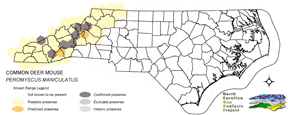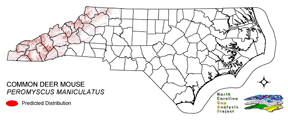
| Taxa: |
| Order: |
| Family: |
| Mammalia |
| Rodentia |
| Muridae |
| NatureServe Global Rank: |
| NatureServe State (NC) Rank: |
| G5 |
| S5 |
| Federal Status: |
| NC State Status: |
| --- |
| --- |


| Land Unit |
| US Fish & Wildlife Service |
| US Forest Service |
| US National Park Service |
| US Department of Defense |
| NC State Parks |
| NC University System |
| NC Wildlife Res. Com. |
| NC Forest Service |
| NC Div. of Coastal Mgmt. |
| Local Governments |
| Non-Governmental Org. |
| Other Public Lands |
| Private Lands |
| GAP Status 1-2 |
| All Protected Lands |
| Statewide |
| Hectares |
| 0.00 |
| 98,447.85 |
| 26.64 |
| 34,575.12 |
| 2,029.68 |
| 18.27 |
| 2,249.10 |
| 534.03 |
| 0.00 |
| 2,345.40 |
| 2,301.12 |
| 5.22 |
| 215,476.29 |
| 51,137.16 |
| 142,443.69 |
| 358,008.72 |
| Acres |
| 0.00 |
| 243,269.89 |
| 65.83 |
| 85,436.97 |
| 5,015.45 |
| 45.15 |
| 5,557.65 |
| 1,870.56 |
| 0.00 |
| 5,795.61 |
| 5,686.19 |
| 12.90 |
| 532,453.40 |
| 126,913.60 |
| 352,536.90 |
| 885,209.59 |
| % of Dist. on |
| Prot. Lands |
| 0.0 % |
| 69.1 % |
| < 0.1 % |
| 24.3 % |
| 1.4 % |
| < 0.1 % |
| 1.6 % |
| 0.4 % |
| 0.0 % |
| 1.6 % |
| 1.6 % |
| < 0.1 % |
| 0.0 % |
| 35.9 % |
| ----- |
| ----- |
| % of Dist. on |
| All Lands |
| 0.0 % |
| 27.5 % |
| < 0.1 % |
| 9.7 % |
| 0.6 % |
| < 0.1 % |
| 0.6 % |
| 0.1 % |
| 0.0 % |
| 0.7 % |
| 0.6 % |
| < 0.1 % |
| 60.2 % |
| 14.3 % |
| ----- |
| ----- |
|
The range of this species extends southward from general forested habitats in the northeastern United States and Canada to the southeastern limit of its breeding range in the southern Appalachians, where, in North Carolina, it occurs on mountain slopes and peaks and in some foothill locations (Lee et al. 1982, Brown 1997). Within the southern Appalachian region, the species is largely associated with cool, moist mixed conifer and deciduous forests or conifer forests (Brown 1997, Whitaker and Hamilton 1998), and also with deciduous forests which contain evergreen shrub thickets (Webster et al. 1985). Rocky, mossy conditions or areas with numerous downed and decaying logs and stumps are favorable nesting and denning sites (Webster et al. 1985). NATURE SERVE GLOBAL HABITAT COMMENTS: Uses a wide variety of upland and riparian habitats from open areas and brushlands to coniferous and deciduous forests. Nest sites as varied as habitat. May be placed in buildings, burrows, under logs, in thick vegetation, or in tree cavities. |
| Code | Name | Description | NC Natural Heritage Program Equivalent |
| 230 | Piedmont Mesic Forest | American Beech - Red Oak - White Oak Forests. | Mesic Mixed Hardwood |
| 383 | Piedmont Mixed Successional Forest | Generally loblolly mixed with successional hardwoods. Sweetgum, tulip poplar and red maple are common co-dominants in these successional forests. | No equivalent |
| 21 | Coniferous Cultivated Plantation (natural / planted) | Managed pine plantations, densely planted. Most planted stands are loblolly, but slash and longleaf occur as well. | No equivalent |
| 51 | Deciduous Cultivated Plantation | Planted deciduous trees. Includes sweetgum and sycamore plantations. | No equivalent |
| 517 | Hemlock Floodplain Forest | Alluvial forest with hemlock and/or white pine in mountains and western piedmont. Hydrology is generally temporarily to seasonally flooded. | Canada Hemlock Forest |
| 522 | Northern Hardwoods | High Elevation forests including yellow birch, American beech, and yellow buckeye. Includes forests with Hemlock and Yellow Birch. | Northern Hardwoods Forest, Boulderfield Forest |
| 526 | Appalachian Cove Forest | Mixed Mesophytic forests of the mountains. Includes tuliptree, basswood, yellow buckeye and surgar maple. This class is mapped to include cove forests dominated or co-dominated by hemlock. | Rich Cove Forest, Acidic Cove Forest |
| 527 | Appalachian Hemlock | Upland hemlock forests of the moutains region. Vary from side slopes to steep slope positions. | Canada Hemlock Forest |
|
Blair, W.F. 1942. Size of home range and notes on life history of the woodland deer mouse and eastern chipmunk in northern Michigan. Journal Mamm. 23(1):27-36.
Kaufman, G. A., D. W. Kaufman, and E. J. Finck. 1988. Influence of fire and topography on habitat selection by PEROMYSCUS MANICULATUS and REITHRODONTOMYS MEGALOTIS in ungrazed tallgrass prairie. J. Mamm. 69:342-352. Sullivan, T. P. 1990. Demographic responses of small mammal populations to a herbicide application in coastal coniferous forest:population density and resiliency. Can. J. Zool. 68:874-883. Hogan, K. M., et al. 1993. Systematic and taxonomic implications of karyotypic, electrophoretic, and mitochondrial-DNA variation in PEROMYSCUS from the Pacific Northwest. J. Mamm. 74:819-831. Childs, J. E., J. N. Mills, and G. E. Glass. 1995. Rodent-borne hemorrhagic fever viruses:a special risk for mammalogists? Journal of Mammalogy 76:664-680. Jones, J. K., Jr., et al. 1992. Revised checklist of North American mammals north of Mexico, 1991. Occas. Pap. Mus., Texas Tech Univ. (146):1-23. Wilson, D. E., and D. M. Reeder (editors). 1993. Mammal Species of the World:a Taxonomic and Geographic Reference. Second Edition. Smithsonian Institution Press, Washington, DC. xviii + 1206 pp. Brown, L. N. 1997. A guide to the mammals of the southeastern United States. University of Tennessee Press, Knoxville. xiv + 236 pp. Whitaker, J.O. Jr. and W.J. Hamilton, Jr. 1998. Mammals of the eastern United States. Cornell Univ. Press, Ithaca, New York. 583 pp. Carleton, M. D. 1989. Systematics and evolution. Pages 7-141 in G. L. Kirkland, Jr., and J. N. Layne, eds. Advances in the study of PEROMYSCUS (Rodentia). Texas Tech Univ. Press, Lubbock. Clark, B. K., and D. W. Kaufman. 1990. Short-term responses of small mammals to experimental fire in tallgrass prairie. Can. J. Zool. 68:2450-2454. Lee, D. S., L. B. Funderburg Jr., and M. K. Clark. 1982. A distributional survey of North Carolina mammals. Occasional Papers of the North Carolina Biological Survey, No. 1982-10. North Carolina State. Mus. Nat. Hist., Raleigh, North Carolina. 72 pp. King, J. A. (ed.). 1968. Biology of PEROMYSCUS (Rodentia). Am. Soc. Mamm. Spec. Publ. No. 2. 593 pp. Banfield, A.W.F. 1974. The mammals of Canada. University of Toronto Press, Toronto. Godin, A.J. 1977. Wild Mammals of New England. Johns Hopkins University Press, Baltimore. 304 pp. Hamilton, William J., Jr., and John O. Whitaker, Jr. 1979. Mammals of the eastern United States. Cornell Univ. Press, Ithaca, New York. 346 pp. Hall, E. R. 1981. The Mammals of North America. Second edition. 2 Volumes. John Wiley and Sons, New York, New York. Millar, J. S., and D. G. L. Innes. 1985. Breeding by PEROMYSCUS MANICULATUS over an elevational gradient. Can. J. Zool. 63:124-129. Schwartz, Charles W., and Elizabeth R. Schwartz. 1981. The wild mammals of Missouri. University of Missouri Press, Columbia. 356 pp. Wolfe, J. O., R. D. Dueser, and K. S. Berry. 1985. Food habits of sympatric Peromyscus leucopus and Peromyscus maniculatus. J. Mamm. 66:795-798. Baker, Rollin H. 1983. Michigan mammals. Michigan State University Press. 642 pp. Gunn, S. J. and I. F. Greenbaum. 1986. Systematic implications of karyotypic and morphologic variation in mainland PEROMYSCUS from the Pacific Northwest. J. Mamm. 67:294-304. Webster, W. D., J. F. Parnell and W. C. Biggs Jr. 1985. Mammals of the Carolinas, Virginia, and Maryland. The University of North Carolina Press, Chapel Hill, NC. Allard, M. W., S. J. Gunn, and I. F. Greenbaum. 1987. Mensural discrimination of chromosomally characterized PEROMYSCUS OREAS and P. MANICULATUS. J. Mamm. 68:402-406. Kirkland, G. L., Jr., and J. N. Layne. 1989. Advances in the study of PEROMYSCUS (Rodentia). Texas Tech Univ. Press, Lubbock. Cramer, K. L., and J. A. Chapman. 1992. Life history characteristics of insular Peromyscus maniculatus in the Bonneville Basin, Utah. Am. Midl. Nat. 128:345-359. |
For more information please contact them at:
NC-GAP Analysis Project
Dept. of Zoology, NCSU
Campus Box 7617
Raleigh, NC 27695-7617
(919) 513-2853
www.basic.ncsu.edu/ncgap